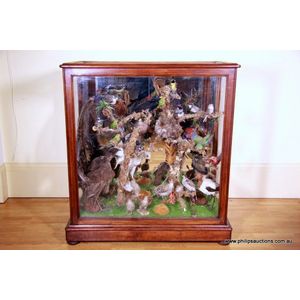Australian Bird Diorama in Mahogany Glass Case
You must be a subscriber, and be logged in to view price and dealer details.
Subscribe Now to view actual auction price for this item
When you subscribe, you have the option of setting the currency in which to display prices to $Au, $US, $NZ or Stg.
- Mahogany - Mahogany is a dense, close grained red-coloured timber from the West Indies and Central America. It was first imported into Europe in the the early 18th century and its use continued through the 19th century. It was popular for furniture making because of its strength, the wide boards available, the distinctive grain on some boards, termed flame mahogany and the rich warm colour of the timber when it was polished.. The "flame" was produced where a limb grew out from the trunk of the tree, and this timber was usually sliced into veneers for feature panels on doors, backs and cornices.
Some terms used to describe mahogany relate to the country from which it originally came, such as "Cuban" mahogany, "Honduras" mahogany etc. However unless the wood has been tested the names assigned are more a selling feature, rather than a true indication of the timber's origin. - Diorama - When used in relation to antiques and collectables, a diorama is a three dimensional display, usually within a domed or rectangular glass case.
As the feathers of birds are more easily damaged than the skin of an animal, most taxidermied birds are displayed within a glazed diorama. The birds will be set in lifelike poses in a naturalistic landscape, usually standing a branch within the diorama. Animals will be displayed set in the landscape they inhabit. The foreground will be set with gravel, rocks and bushes, while the background will be painted.
While most natural history dioramas can be easily picked up and carried by one person, some larger examples were made that were suitable for display at exhibitions.
The other type of diorama commonly seen is a model ship enclosed in a rectangular glass box, the ship depicted floating on the sea.
This item has been included into following indexes:
- natural history and taxidermy, bird specimens
- natural history and taxidermy, dioramas and cased exhibits
Visually similar items

An English oak hall cupboard, in the 16th century style But 19th century, with linenfold mouldings and Gothic architrave and armorial mouldings in relief, iron fittings, the inset panelled interior with later hanging rail installed, 96 width x 52 depth x 1

Georgian oak corner cabinet, with later marble top. 100 cm high, 79 cm wide at the front

A French neoclassical mahogany display cabinet, early 20th century, with an extended cornice above a single glazed cupboard and side panels, with three glazed shelves to the interior, a shaped apron and raised on generous toupie feet, with simple brass str

A cedar single door cabinet. Early 20th century, the cabinet with an extended top above a single cupboard with a vertical strapwork feature opening to shelving and raised upon toupie feet. Height 112 cm. Width 93 cm. Depth 41 cm
